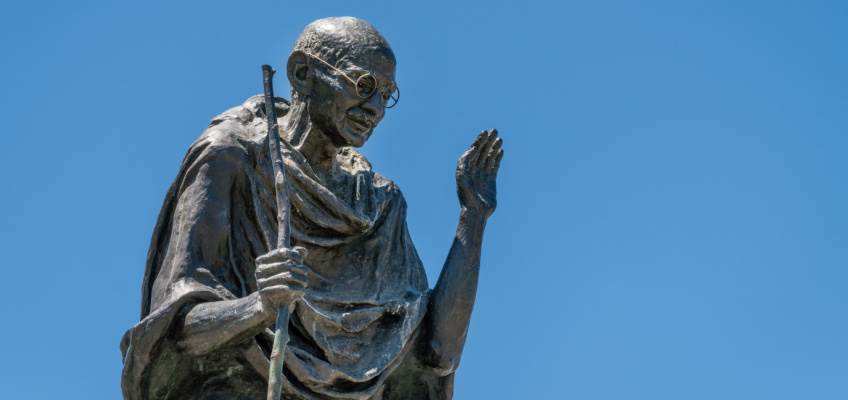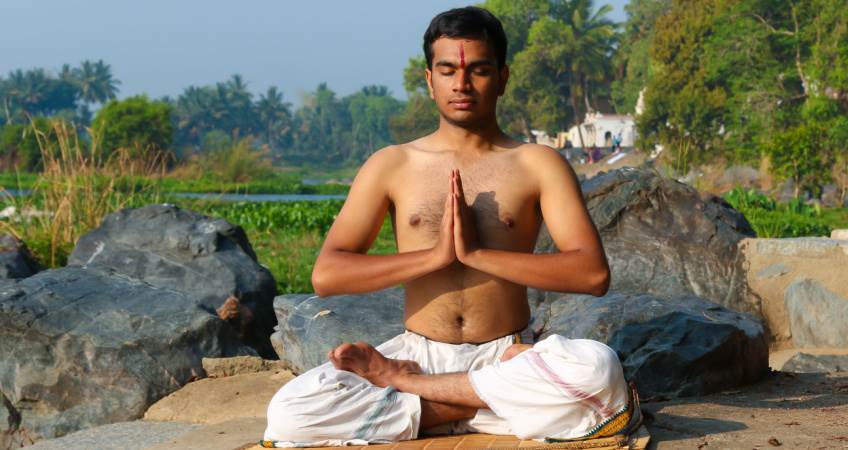Linking Hinduism and Modern Spirituality: Ancient Wisdom to New Age by Psychic Raina
Date 10/17/2024
Explore More:
Spirituality
Did you know that each time you balance your chakras, say an affirmation, chant a mantra, or talk about mindfulness, you're actually taking inspiration from Hinduism? Modern spiritually and New Age ideas, like, karma, meditation, yoga, mindfulness, and conscious living are all relatively new and all have roots in the ancient wisdom of India. The teachers that brought Hindu teachings to the West starting in the late 19th and early 20th century and have profoundly shaped modern spirituality. These concepts become an integral part of our everyday culture, influencing people on their spiritual paths, and even impacting the psyche and vocabulary of the Western world at large.

The History of Hinduism Explained
Before the influx of Eastern thought in the mid-19th century, spirituality in the West was predominantly shaped by Judeo-Christian traditions and Greco-Roman philosophical ideas. Concepts like monotheism, salvation, morality, and divine revelation were central to Western spirituality. However, some individuals found certain aspects of Judeo-Christian thought limiting, such as rigid dogmas, hierarchical structures, and the focus on guilt and original sin.
The introduction of Eastern thought and philosophies in the 19th and 20th centuries brought new perspectives to the Western spiritual landscape. Concepts like meditation, mindfulness, interconnectedness, and non-dualism resonated with seekers looking for alternative spiritual paths. Factors like increased trade, travel, and communication with the East, as well as the rise of spiritual seekers and counter-culture movements, contributed to the popularity of Eastern thought in the West. The appeal lies in its experiential approach, emphasis on personal growth, and the exploration of a broader range of spiritual perspectives beyond traditional Western religious doctrines. The integration of Eastern concepts enriched and expanded Western spirituality, providing a deeper understanding of the human experience and the nature of reality.
The appeal of Eastern thought in the West was fueled by the concept of direct spiritual realization and the notion that individuals could attain a profound understanding of the divine without the need for intermediaries. This contrasted with Western religious doctrines that emphasized the role of intermediaries, such as priests, in mediating between individuals and God. The idea that one could know God and recognize their own divine nature resonated deeply with seekers, offering a more empowering and liberating perspective compared to the notion of being inherently sinful and at risk of punishment. The allure of Eastern thought lies in the possibility of personal spiritual growth, direct communion with the divine, and the pursuit of inner transformation, guiding individuals towards a deeper sense of self-realization and divine connection.

Key Figures in Popularizing Eastern Wisdom
The West's interest in Eastern thought was profoundly influenced by several key figures who played pivotal roles in bringing Eastern wisdom to a broader Western audience:
Ralph Waldo Emerson: An influential American philosopher and writer, Ralph Waldo Emerson, drew inspiration from the Bhagavad Gita*, an ancient Hindu scripture. His exploration of Eastern concepts sowed the seeds of Eastern influence in the West, inspiring many to delve deeper into the teachings of Hindu philosophy and spirituality.
Mahatma Gandhi and Martin Luther King Jr.: Mahatma Gandhi (seen above), a prominent leader of India's nonviolent independence movement, rooted his approach in Hindu principles, including the concept of Ahimsa (nonviolence). His philosophy profoundly influenced Martin Luther King Jr., who adopted nonviolent resistance as a powerful tool in the civil rights movement in the United States.
Carl Jung: A pioneer in modern psychology, Carl Jung, the founder of analytical psychology, was deeply interested in Eastern thought, including the Bhagavad Gita. His encounters with Eastern philosophies significantly influenced his understanding of the human psyche and the concept of the collective unconscious, broadening the scope of Western psychology.
Parmahansa Yogananda and Yogi Bhajan: Parmahansa Yogananda, an Indian yogi and spiritual teacher, authored "Autobiography of a Yogi," which introduced millions to the profound depths of Hindu philosophy and the transformative power of Yoga. Similarly, Yogi Bhajan, another spiritual teacher, brought Kundalini Yoga to the West, enriching the spiritual landscape with ancient practices.
The Beatles: In the 1960s, the iconic British rock band, The Beatles, traveled to India to study transcendental meditation under Maharishi Mahesh Yogi. Their visit introduced millions to meditation and Yoga, shining a spotlight on these ancient practices and fostering widespread interest in Eastern spirituality. Songs from George Harrison like “My Sweet Lord” and John Lennon’s “Imagine” were part of their spiritual journey.
Baba Ram Das (Richard Alpert): Formerly known as Richard Alpert, Baba Ram Das was an American spiritual teacher who underwent a profound transformation after encountering Hindu teachings and spiritual masters. He became a pivotal figure in popularizing Eastern concepts like mindfulness, conscious living, meditation, and Yoga through his influential book "Be Here Now."
The collective impact of these influential figures helped bridge the East-West cultural divide and sparked a renewed curiosity and interest in Eastern thought. Their works and teachings opened doors to a deeper exploration of Eastern philosophies, practices, and spiritual traditions, enriching Western spirituality with a diverse array of insights and perspectives.
* The Bhagavad Gita is a revered scripture in Hinduism, part of the larger epic, the Mahabharata. It offers profound spiritual wisdom and guidance, addressing life's complexities, dharma (duty), and paths to self-realization. Through its teachings on various forms of yoga, devotion, and self-inquiry, it serves as a timeless guide for ethical living, decision-making, and spiritual growth. The Gita's universal relevance and inspirational nature have made it a cherished source of wisdom for seekers throughout history.

Basic Hindu Beliefs
This confluence of Eastern and Western thought has since led to the emergence of a more holistic and inclusive approach to spirituality, emphasizing the interconnectedness of all beings and the pursuit of inner peace, self-discovery, and spiritual growth and understanding the roots of our spiritual practices as originating from Hinduism is beneficial for various reasons:
First, it allows us to appreciate the rich cultural and historical heritage of Hinduism and acknowledges the profound contributions of this ancient tradition to the world's spiritual and philosophical knowledge.
Second, knowing the origins of our practices provides a deeper context and understanding of their meaning and significance, enabling us to explore the philosophical, ethical, and moral foundations upon which they were built. This understanding fosters authenticity and respect in approaching our practices, preventing the misappropriation of sacred teachings and symbols while honoring their cultural and spiritual significance.
Furthermore, delving into the roots of our practices helps us avoid reducing them to superficial trends or fads, embracing their full depth and transformative potential. It also promotes a sense of interconnectedness among diverse spiritual traditions, emphasizing unity and harmony among people following different paths but sharing common philosophical underpinnings.
Understanding the influence of Hinduism on modern spirituality provides a strong foundation for spiritual growth, drawing wisdom from ancient teachings and integrating them into our lives for a more meaningful and purposeful spiritual journey.
Moreover, this awareness encourages healthy cultural exchange and fosters mutual respect among spiritual communities, promoting open dialogue and learning from different traditions. Lastly, comprehending the impact of Hinduism on spiritual practices in the West broadens our global perspective, highlighting the universality of spiritual truths and the interconnectedness of humanity in the pursuit of higher consciousness.

Hinduism and Yoga, Chakras, Mindfulness, and More
While the terms: Yoga, Chakras, Mindfulness, Karma, Mantras, and the Om symbol all have found themselves in modern day spirituality and carry profound spiritual significance, in the New Age movement, they have sometimes been taken out of their full context or cherry-picked, losing some of their original meaning. Let's take a moment and dig deeper into what these concepts really mean and their profound spiritual significance.
Mindfulness stands out in the modern day as a practice rooted in Hinduism and Buddhism that has transcended into everyday vernacular with the focus being both spiritual and embraced in the secular world as well. Mindfulness encourages us to embrace the present moment with unwavering awareness, free from judgment. Through this practice, we rediscover the beauty of inner peace and our profound connection with the world around us.
Yoga, which originated from Hinduism means “union,” and is not just a physical exercise but a pathway to self-discovery and spiritual transformation. It's about uniting the body, mind, and spirit, fostering harmony within us and the universe. Yoga as a practice is a way of life and embraces 8 concepts or limbs, as written about in Pantajali’s Yoga Sutras**, in which only of these is actual yoga on the mat. The rest includes concepts of right living, non-violence, breathwork, meditation and finally samadhi (perfect union and bliss).
- The four yogas of Hinduism are Raja Yoga (meditation), Karma Yoga (selfless action), Bhakti Yoga (devotion), and Jnana Yoga (knowledge). Raja Yoga focuses on meditation and controlling the mind, Karma Yoga emphasizes selfless service without attachment to outcomes, Bhakti Yoga involves devotion to the divine through rituals and love, and Jnana Yoga centers on intellectual inquiry to understand the true nature of the self and ultimate reality. These paths help individuals achieve spiritual growth, self-realization, and liberation (Moksha).
Chakras, another profound concept from Hinduism, are energy centers within our bodies. When understood and balanced in their full context, chakras promote physical, emotional, and spiritual well-being, connecting us to our true essence.
Karma, the law of cause and effect, is not just about "what goes around comes around." It's a deeper understanding of how our actions shape our present and future, and how making mindful choices can lead to positive transformations. Karma simply means action, and it is our actions, all of them positive and negative, that determine what we face in life.
Mantras, sacred chants, or sounds, have spiritual power and significance in Hinduism. They are more than affirmations; they are tools for invoking transformative energies and higher states of consciousness.
The OM symbol, often seen and used in the New Age movement, represents the primordial sound of the universe that permeates everything. The OM symbol is not just a trendy accessory; it's a powerful symbol of unity, a connection to the divine, and a representation of the eternal cosmic vibration.
By embracing the true essence and richness of these concepts and understanding the depth and transformative power they hold, we can unlock their full transformative power and enrich our spiritual journey, uniting our pursuit of inner peace, love, and a deeper connection with the vast universe that surrounds us.
The New Age spiritual practices serve as a captivating gateway to the profound depths of spirituality, offering a glimpse into transformative wisdom that awaits exploration, far beyond what it even realizes lies within. And by going deeper, to the roots, you will find Hinduism is a magnificent tradition worthy of exploration, steeped in richness and fullness. Its primary purpose is to equip you with the tools to recognize and embrace your True Divine Nature as it allows you to discover the full glorious experience of your authentic self.
**Patanjali's Yoga Sutras is a foundational text in the practice of yoga. It outlines the philosophical principles and practices of Raja Yoga (the path of meditation). The Sutras cover the nature of the mind, the eight limbs of yoga, and the state of enlightenment. Patanjali's teachings emphasize self-discipline, concentration, and the control of mental fluctuations (chitta vritti) to attain spiritual liberation. This ancient scripture remains a valuable guide for seekers on their journey toward inner peace and self-realization.
 Get a Reading with Raina x3342
Get a Reading with Raina x3342
Psychic Raina is a clairvoyant, intuitive, certified medium and Reiki Master. She has studied Tarot for more than 20 years as taught within hermetic mystery schools and is heavily influenced by Eastern Esoteric thought. Raina is well versed in symbolism, numerology, archetypes, and mysticism. Over time she has developed her own method to quickly access the secret knowledge contained within the tarot. Raina regularly teaches masterclasses on tarot mastery and tarot symbolism beyond the written meaning. Her decks of choice are the Thoth tarot and Rider Waite. Her readings are non-judgmental, reality based and spirituality focused.

Leave A Comment
You must be logged in to leave a comment. click here to login

